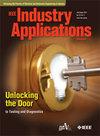Decomposition of Carbon Particles on a Glass Surface by Plasma Generated Using Discharge Electrodes Combined With Floating Electrodes
IF 4.2
2区 工程技术
Q2 ENGINEERING, ELECTRICAL & ELECTRONIC
引用次数: 0
Abstract
Incineration of carbon particles by nonthermal plasma using surface dielectric barrier discharge (SDBD) units were conducted, and their performances were compared with and without floating electrode. The floating electrodes were attached a few millimeters from the discharge electrode edges to create a potential gradient along the dielectric surface to extend the plasma region. Carbon black was used as a model for the soot collected from diesel exhaust gas. The distributions of carbon particles on the SDBD unit were analyzed by processing the images obtained with a photo scanner. The results show that the reduction of carbon particles was enhanced by the floating electrode for all the cases of carbon loadings (0.11–0.45 mg per the SDBD unit) with no increase in power consumption. The maximum increase in the reduction ratio was approximately 43% with 0.11 mg carbon loading. These results contribute to the development of PM (particulate matters) aftertreatment devices for diesel engines using electrostatic and nonthermal plasma.求助全文
约1分钟内获得全文
求助全文
来源期刊

IEEE Transactions on Industry Applications
工程技术-工程:电子与电气
CiteScore
9.90
自引率
9.10%
发文量
747
审稿时长
3.3 months
期刊介绍:
The scope of the IEEE Transactions on Industry Applications includes all scope items of the IEEE Industry Applications Society, that is, the advancement of the theory and practice of electrical and electronic engineering in the development, design, manufacture, and application of electrical systems, apparatus, devices, and controls to the processes and equipment of industry and commerce; the promotion of safe, reliable, and economic installations; industry leadership in energy conservation and environmental, health, and safety issues; the creation of voluntary engineering standards and recommended practices; and the professional development of its membership.
 求助内容:
求助内容: 应助结果提醒方式:
应助结果提醒方式:


